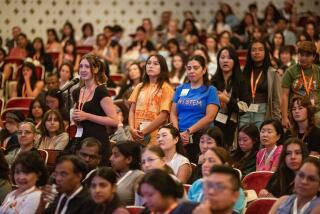Colleges’ gender gap
Who’s smarter, men or women? It’s a topic of common -- and often comic -- musings, but it has also become a serious policy issue for colleges and this nation’s students.
After 17 years of concentrated effort to raise the academic achievement of girls, who in previous decades had often received less attention in the classroom and been steered away from college-prep courses, the nation can brag that female students have progressed tremendously. Though still underrepresented in calculus and other advanced-level science and math courses in high school, women now outnumber men applying to and graduating from college -- so much so that it appears some colleges are giving male applicants an admissions boost. As a result, the U.S. Commission on Civil Rights is examining whether colleges are engaging in widespread discrimination against women in an effort to balance their male and female populations.
Consider some of the numbers at leading schools: At Vassar College in New York State, a formerly all-women’s college that is still 60% female, more than two-thirds of the applicants last year were women. The college accepted 35% of the men who applied, compared with 20% of the women. Locally, elite Pomona College accepted 21% of male applicants for this year’s freshman class, but only 13% of female applicants. At Virginia’s College of William & Mary, 7,652 women applied for this year’s freshman class, compared with 4,457 male applicants. Yet the numbers of each who gained admittance were nearly the same. That’s because the college accepted 45% of the men and only 27% of the women.
A 2007 analysis by U.S. News & World Report, based on the data sent by colleges for the magazine’s annual rankings, found that the admissions rate for women averaged 13 percentage points lower than that for men. But percentages don’t tell the whole story. It could be that the men were stronger candidates, or they might have applied in areas of engineering and science where women’s numbers are still lower. But such justifications, even if true, are unlikely to fully explain these numbers. At schools such as the University of California, where admissions rely overwhelmingly on statistical measures of academic achievement such as grades and test scores, the disparities don’t appear. Far more women than men applied to UCLA -- the UC’s most selective campus -- last year. The university accepted about the same percentage of each, with a slight edge to the women. As a result, the freshman class has close to 800 more women than men.
In recent years, several college leaders have admitted that their institutions give a boost to male applicants to maintain gender balance on campus. Most students of either sex, they point out, prefer such balance. If Vassar accepted equal percentages of each sex, women would outnumber men by more than 2 to 1.
The dean of admissions at Kenyon College in Ohio, a formerly all-male school, brought the matter to broad public attention in 2006 with an Op-Ed article for the New York Times describing the dilemma of her admissions office. “What messages are we sending young women that they must . . . be even more accomplished than men to gain admission to the nation’s top colleges?” Jennifer Delahunty Britz wrote.
This page has long favored allowing colleges to use race as an admissions factor in order to diversify student populations. Exposure to people of different backgrounds and viewpoints better educates all students -- not just those given a leg up. We are not in favor of accepting underqualified or clearly inferior students for the sake of diversity. But most colleges are inundated with applications from students who more than meet their standards; the differences among many of them are slight. It makes sense for colleges to pick a balanced population from within this group. At the same time, admissions officers should avoid rigid notions of what constitutes enough men on campus. It’s not harming UCLA, or destroying college social life, to admit somewhat more women than men.
Even if the civil rights commission finds pervasive gender discrimination in admissions, there’s little it could do about the situation. Such discrimination -- though not racial discrimination -- is legal for undergraduate admissions at private, nonprofit colleges, even those that receive federal funding. It is illegal at public colleges as well as graduate and professional schools. Commission documents on the inquiry suggest that colleges could find more “gender-neutral” ways of balancing their student numbers, perhaps by offering programs and extracurricular activities that attract men.
Those might work for some schools, but won’t change the overall scenario. Not with college populations composed of 57% women nationwide. The issue we’d like the Commission on Civil Rights to investigate is: What’s happening with the education of U.S. boys? Why are so few of them applying to and graduating from college?
Theories and arguments abound. Some say that boys are more active and thus less able to sit still for long periods -- and as a result, more likely to be categorized as having attention deficit/hyperactivity disorder or needing special education. A 2008 study by researchers at Northwestern University found that when girls are involved in a language-related task -- such as reading -- they show more activity in areas of the brain involved in encoding language. Boys use more sensory information to do linguistic tasks. The study suggests boys might do better if they were taught language arts in different ways. Race is a factor as well. The gender gap is starker among African American and Latino students.
There may be no one reason -- or solution. But figuring out ways to help boys achieve in school is a better response to the gender gap than making it easier for them to get into college later.






